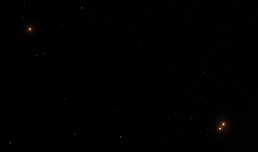
The entire Qrur'uqaz system
Qrur'uqaz is a quadruple star system located in the Ouranir Galaxy. It consists of an M2 and L1-Class star extremely close together, and a distant M5-Class star. The fourth star is an M4-Class 825AU away. This M4 has no lifebearing worlds around it, however early computer returns suggested 3 lifebearing planets in the vicinity of the other three. Subsequent study revealed there were only 2 major races here, and that the extra return was caused by one of the societies inhabiting two planets.
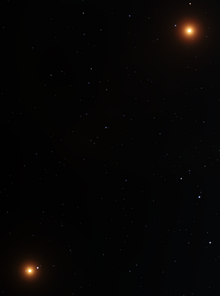
A closer view of the two stars to the right in the above picture.
After initial study during which technological assessments were done, it was determined that this race, called the Qrur'uq have only a "sub-warp" drive, so the Isvoy went into "Observation Only" mode as per the Contact Directive.
Observation[]
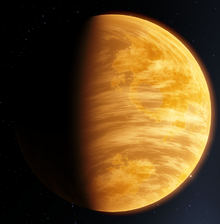
Qrur'uqaz
During the one month-long observation it was revealed that the Qrur'uq hail from a planet orbiting the M2 and L1 star but the inhabitants know this world as Qrur'uqaz, so the entire star system was given this name as well.
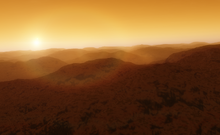
Close to the terminator on the planet, showing the thick atmosphere and mountains.
During observations, it was revealed the Qrur'uq were moving due to their extremely dense atmosphere, at 1,683atm. Scientists aboard the Isvoy were baffled as to how an intelligent species had evolved here under such harsh conditions, and the Qrur'uq seemed to know that too, hence the move. Their terraforming skills seemed to be extremely advanced, although they have not developed warp drive yet. The technological assessments indicated that they were extremely close.
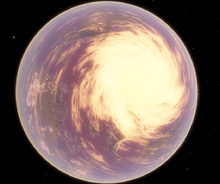
Qrur'uq-nal
That is how they found another suitable world. The computer gave this world a planet designator of AB3. Dubbed "Qrur'uq-nal", it is also a warm E-Class that is somewhat smaller than the Qrur'uq homeworld. The mass was measured at half that of Qrur'uqaz. It is significantly closer to the M5 Dwarf, at an average distance of 9.4 million kilometers. It orbits in 15.4 days, has a gravity of 1.08 Gs, and a temperature of 31.3 Centigrade.
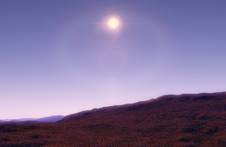
Some mountains on Qrur'uq-nal. Note the cracked dirt. Studies show that this planet was previously a desertic world prior to terraforming.
The atmosphere was measured at 0.284atm at the start of the observation, but it was measured again just before departing and it had risen to 0.297, indicating an active terraforming attempt. The Qrur'uq here look very different from their cousins on the homeworld, having shed their special atmosphere suits.
The Qrur'uq[]
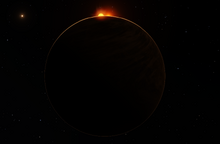
Qrur'uqaz backlit by the two suns.
The Qrur'uq seem to not have had an extremely dense atmosphere until very recently, judging from their appearance. They resemble humans, but are a bit shorter, more muscular, with black skin. They seemed to not have a religion, instead relying on science to see them through tough times.
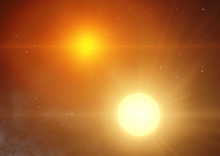
Close-up of the two suns. M2-Class in the lower right, L1 class above it.
Translated news broadcasts suggest the runaway atmosphere buildup was caused by a small asteroid that crashed into the planet, which had something in it. Although it could have been a weapon from one of the Qrur'uq's enemies, if they have any. More research is required to determine potential adversaries.
The L'torul[]

L'torul homeworld
The other species the Isvoy discovered here, their planet has a designator of AA4. It is an oceanic planet, the next one out from Qrur'uqaz. Undersea scans have revealed numerous cities, but the absence of any spacecraft within the vicinity puts this planet at a Mid-Type-0 society. Also, it seemed as if there was some type of war under the waves, since the detection of crumbled buildings was detected. Their age was dated to be fairly recent; within 40 years.
"The War Under the Waves"[]
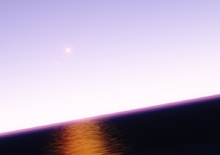
The surface of the L'torul homeworld. The atmosphere cuts out the glare of the two stars, easily making them visible.
A repeat visit to the L'torul homeworld scanned the surface, and attempted to piece together what caused the "war under the waves." Studies concluded it was a war fought between two large countries, sparked off by a border dispute. L'torul law in the northern country states that a country's "airspace" only goes as high as the surface of the ocean, as anything higher is considered "Wildsky"; I.E. what humans call "Outer Space". The southern country included the first 500 meters over the ocean. The northern country started trying to exploit this law and began "jumping" their aircraft-equivalents out of the water and "over" the airspace of the southern country at a fairly narrow part of the border, no more than half a kilometer wide. This, it was learned, was a pretty good time-saving shortcut between two northern cities, and it was utilized for little over a local year before the Southern country found out that Northern A.E.s were not launching out of the water fast enough to attain the altitude needed, and flew below the 500 meter limit. When they did find out, they sent messages to the Northern government to cease the practice or face repercussions. The northern country continued, since they thought they were clearly over the 500 meter line. The result? a massive war between the two nations, with, ironically, the northern country winning the war. Since then, all countries under the waves only have their "airspaces" go up to the surface of the ocean.
Qrur'uq-L'torul knowledge[]
There is evidence that the Qrur'uq know about the L'torul, but leave the "inferior beings" alone, suggesting a superiority complex that is pervasive throughout Qrur'uq society. Indeed, studies have shown that Qrur'uq society is rife with insubordination.
Comments[]
During the observation, it became clear that the Qrur'uq are a violent race, but they had put that all aside to move their entire race to Qrur'uq-nal, suggesting they CAN co-operate with each other. Scientists aboard the ship express optimism that if, and when they find out that there is more life outside of their system, that they will cease being so hostile, and seek co-operation with their neighboring civilization.
The L'torul are not so fortunate. They are likely to become wiped out as the Qrur'uq become ever more concerned about the other life in their midst. It was estimated that they will cease to exist in 120 years. Things can change however, and optimism runs high that they can and will be able to learn to work together.
